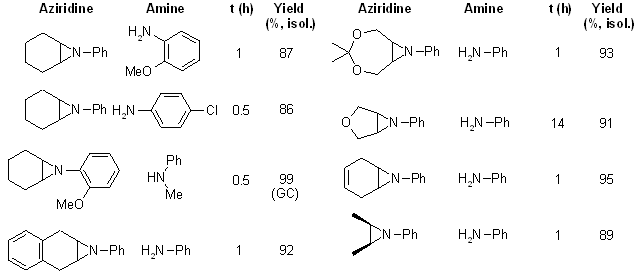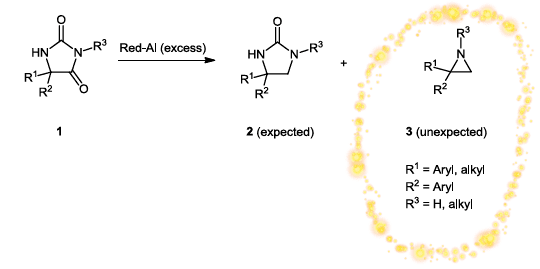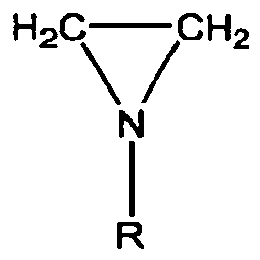Formula C2H5N Boiling point 57 °C | Density 832 kg/m³ Melting point -77.9 °C | |
 | ||
Appearance Clear colorless oily liquid Related heterocycles | ||
Aziridines are organic compounds containing the aziridine functional group, a three-membered heterocycle with one amine group (-NH-) and two methylene bridges (-CH
2-). The parent compound is aziridine (or ethylene imine), with molecular formula C
2H
5N.
Contents
- Aziridine ring opening and 1 3 dipolar cycloaddition csir chemical science answer
- Structure
- Synthesis
- Cyclization of haloamines and amino alcohols
- Nitrene addition
- Triazoline decomposition
- From epoxides
- From oximes
- Unprotected N H and N Me aziridines from Mono Di Tri and Tetra substituted Alkenes olefins
- Nucleophilic ring opening
- 13 dipole formation
- Other
- Human toxicology
- Exposure
- Carcinogenicity
- References

Aziridine ring opening and 1 3 dipolar cycloaddition csir chemical science answer
Structure

The bond angles in aziridine are approximately 60°, considerably less than the normal hydrocarbon bond angle of 109.5°, which results in angle strain as in the comparable cyclopropane and ethylene oxide molecules. A banana bond model explains bonding in such compounds. Aziridine is less basic than acyclic aliphatic amines, with a pKa of 7.9 for the conjugate acid, due to increased s character of the nitrogen free electron pair. Angle strain in aziridine also increases the barrier to nitrogen inversion. This barrier height permits the isolation of separate invertomers, for example the cis and trans invertomers of N-chloro-2-methylaziridine.
Synthesis
There are several syntheses of aziridines (aziridination).
Cyclization of haloamines and amino alcohols

An amine functional group displaces the adjacent halide in an intramolecular nucleophilic substitution reaction to generate an aziridine. Amino alcohols have the same reactivity, but the hydroxy group must first be converted into a good leaving group. The cyclization of an amino alcohol is called a Wenker synthesis (1935), and that of a haloamine the Gabriel ethylenimine method (1888).
Nitrene addition

Nitrene addition to alkenes is a well-established method for the synthesis of aziridines. Photolysis or thermolysis of azides are good ways to generate nitrenes. Nitrenes can also be prepared in situ from iodosobenzene diacetate and sulfonamides, or the ethoxycarbonylnitrene from the N-sulfonyloxy precursor.
Triazoline decomposition
Thermal treatment or photolysis of triazolines expels nitrogen, producing an aziridine. Triazolines can be generated by cycloaddition of alkenes with an azide.
From epoxides

One method involves the ring-opening reaction of an epoxide with sodium azide, followed by organic reduction of the azide with triphenylphosphine accompanied by expulsion of nitrogen gas:

The other method involves the ring-opening reaction of an epoxide with amines, followed by ring closing with the Mitsunobu reaction.
From oximes
The Hoch-Campbell ethylenimine (Aziridine) synthesis is the reaction of certain oximes with Grignard reagents:
Unprotected N-H and N-Me aziridines from Mono-, Di-, Tri-, and Tetra-substituted Alkenes (olefins)
In 2014, a new method was described to produce Aziridines By reacting an Alkene (olefin) with O-(2,4-dinitrophenyl)hydroxylamine (DPH) via homogeneous rhodium catalysis, alone. This method is operationally simple (i.e., one-pot) with excellent yield.
Alkene + DPH (in presence of Rhodium catylist) -> Aziridine.
Phe-Aziridine-Me can then undergo a simple ring opening reaction to form dextroamphetamine and levoamphetamine (the two active ingredients in Adderall).
Nucleophilic ring opening
Aziridines are reactive substrates in ring-opening reactions with many nucleophiles due to their ring strain. Alcoholysis and aminolysis are basically the reverse reactions of the cyclizations. Carbon nucleophiles such as organolithium reagents and organocuprates are also effective.
One application of a ring-opening reaction in asymmetric synthesis is that of trimethylsilylazide TMSN
3 with an asymmetric ligand in scheme 2 in an organic synthesis of oseltamivir:
1,3-dipole formation
Certain N-substituted azirines with electron withdrawing groups on both carbons form azomethine ylides in an electrocyclic thermal or photochemical ring-opening reaction. These ylides can be trapped with a suitable dipolarophile in a 1,3-dipolar cycloaddition.
When the N-substituent is an electron-withdrawing group such as a tosyl group, the carbon-nitrogen bond breaks, forming another zwitterion TsN−
–CH
2–CH+
2–R
This reaction type requires a Lewis acid catalyst such as boron trifluoride. In this way 2-phenyl-N-tosylaziridine reacts with alkynes, nitriles, ketones and alkenes. Certain 1,4-dipoles form from azetidines.
Other
N-unsubstituted aziridines can be opened with olefins in the presence of strong Lewis acid B(C
6F
5)
3.
Human toxicology
The toxicology of a particular aziridine compound depends on its structure and activity, although sharing the general characteristics of aziridines. As electrophiles, aziridines are subject to attack and ring-opening by endogenous nucleophiles such as nitrogenous bases in DNA base pairs, resulting in potential mutagenicity.
Exposure
Inhalation and direct contact. Some reports note that the use of gloves has not prevented permeation of aziridine. It is therefore important that users check the breakthrough permeation times for gloves, and pay scrupulous attention to avoiding contamination when degloving. Workers handling azidrine are expected to be provided with, and required to wear and use, a half-mask filter-type respirator for dusts, mists and fumes.
There is relatively little human exposure data on aziridine. This is because it is considered extremely dangerous. In industrial settings, class A pressure suits are preferred when exposure is possible.
Carcinogenicity
The International Agency for Research on Cancer (IARC) has reviewed aziridine compounds and classified them as possibly carcinogenic to humans (IARC Group 2B). In making the overall evaluation, the IARC Working Group took into consideration that aziridine is a direct-acting alkylating agent which is mutagenic in a wide range of test systems and forms DNA adducts that are promutagenic.
Irritancy
Aziridines are irritants of mucosal surfaces including eyes, nose, respiratory tract and skin.
Sensitization
Aziridine rapidly penetrates skin on contact.
Skin sensitizer — causing allergic contact dermatitis and urticaria.
Respiratory sensitiser — causing occupational asthma
